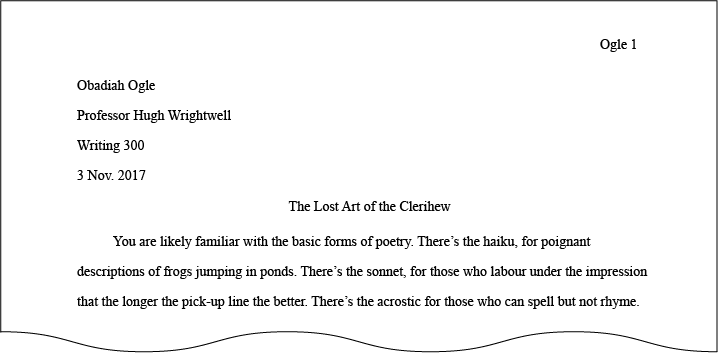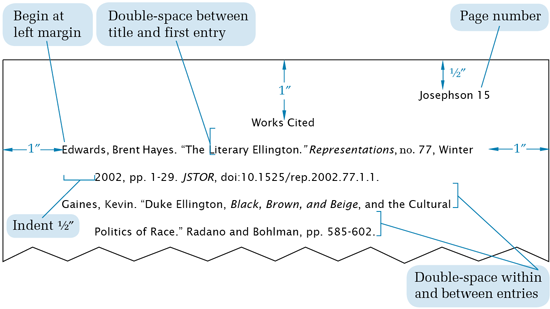Modern Language Association (MLA) style is one of the most commonly used approaches for citing sources and formatting papers, especially within the humanities and liberal arts disciplines. The MLA format specifies the guidelines for formatting papers using the English language. The style also offers writers a system for citing and referencing sources using a parenthetical system of in-text citation and a Works Cited page.

Different instructors request different formatting styles in line with the discipline and the department. In the event that you are asked to use the MLA format in your essay, you will have an opportunity to organize your paper in a way that is not only appealing but also easy to follow. MLA citation also gives your writing credibility by showing that you are accountable to the sources of your evidence. Most importantly, the proper use of the MLA style can protect you from accusations of plagiarism, which is the accidental or purposeful use of source material without credit to those sources.
When asked to use the MLA format for your essay, please make sure you consult the MLA Handbook (8th edition). The handbook can be accessed in most reference libraries and writing centers, as well as the MLA website. Here are some tips for producing good papers using the MLA format:
- Page details
When formatting your paper using MLA style, please note that MLA papers do not require a title page. Instead, all the necessary information is placed on the first page. The publication information to include in your first page is your name, the name of your instructor, the course title, and the date of assignment completion. Do not add labels like ‘Course’ or ‘Date.’ Here is a sample of what your paper ought to look like:

- Header information
Another important element of MLA formatting for essays is the header section. This is the section where you include your surname and the page number. The information is placed in the upper right-hand corner of the paper and is flushed with the right margin. Make sure that you do not place the abbreviation “p.” before the page number as some students do. In addition, do not use hyphens, periods, or any other symbols in the header. The word processing tool should allow you to add the header details to the remaining pages automatically. There are instructors who do not want the header information in the first page. Make sure that you confirm your instructor’s preferences. See the figure below for an example of header information:
- Margins
Margins are another important consideration when using MLA formatting. The default margins for MS Word is 1 inch all around, which is also the requirement for MLA formatting. In case you need to be sure, go to page layout, where you will find different margin options.
- Font, spacing, and alignment
The ideal font for formatting MLA papers is Times New Roman, size 12. Do not fall the temptation of altering the font in the hope that your instructor will not notice. Do not justify the lines of your text using the right margin. Make sure that the entire paper is double-spaced. Double spacing ensures that your text is presentable and easy to read.
- Citation and referencing
Proper citation and referencing is the hallmark of all good academic writing. Scholars (you are becoming one) write for their peers, communicating the finding of their analyses and research. In the academic discourse, writers seek out relevant publications and books to learn from and build on their ideas. The source of your information must be authoritative and verifiable. Proper citation gives your readers a way to verify the authenticity of your data, besides shielding you from accusations of plagiarism.
In MLA, sources are cited within the text using a parenthetical format, where the authors’ surnames are indicated together with the page number from where the information was obtained. In situations where the author has been mentioned in the sentence, then there is no need for repeating it within the parenthesis. The in-text citation must correspond to an entry in the list of Works Cited at the end of the paper. The Works Cited list informs your readers of the details of the sources from which you got the information supporting your arguments. The Works Cited must be given its own page.
- Placement of the Works Cited List
The listing of the sources cited within the text conventionally appears at the end of the paper. The Works Cited page contains the same running head and page numbering as the rest of the paper. The title, ‘Works Cited,’ is centered, an inch from the top of the page. In the event that the list only comprises one source entry, then the page is titled ‘Work Cited.’ Each entry is written with a hanging indentation, based on alphabetical order. Conform to the number of references indicated by your instructor. Here is an illustration to give you an idea:
- Illustrations and tables
An important consideration when using MLA formatting for academic essays concerns the use of tables and figures to strengthen arguments. If you choose to include charts and tables in your work, place them as close as possible to the parts of the text to which they are connected. Tables and figures must also be labeled appropriately. If taken from other sources, the tables and illustrations must also be labeled properly.
To summarize, this article discusses MLA formatting for essays, including a look at some important elements of MLA formatting. The information contained here should give you a good idea on how to proceed with MLA formatting and citation. However, if you need more information, it is recommended to look at the official guidelines contained in the MLA Handbook. As you can see from the tips provided and the illustrations, MLA formatting is neither cluttered nor flashy. Unless you are requested to provide additional information by your instructor, do not feel the urge to do so. Good formatting takes practice, so keep writing.